Modelling Hydrology and Sediment Transport in a Semi-Arid and Anthropized Catchment Using the SWAT Model: The Case of the Tafna River (Northwest Algeria)
Abstract
:1. Introduction
2. Materials and Methods
2.1. Study Site
2.2. Discharge and Sediment Monitoring
2.3. Modelling Approach
2.3.1. The SWAT Model
The Hydrological Component in SWAT
Suspended Sediment Modelling Component in SWAT
2.4. SWAT Data Inputs
2.5. Model Calibration
2.6. Model Evaluation
3. Results
3.1. Discharge and Sediment Calibration
3.2. Impact of Dams on Water Balance and Sediment Loading
3.2.1. Impact of Dams on Water Balance
3.2.2. Impact of Dams on Sediment
4. Discussion
5. Conclusions
Acknowledgments
Author Contributions
Conflicts of Interest
References
- Souza, J.O.P.; Correa, A.C.B.; Brierley, G.J. An approach to assess the impact of landscape connectivity and effective catchment area upon bedload sediment flux in Saco CreekWatershed, Semiarid Brazil. Catena 2016, 138, 13–29. [Google Scholar] [CrossRef]
- Roudi-Fahimi, F.; Kent, M. Challenges and opportunities—The population of the Middle East and North Africa. Popul. Bull. 2007, 62, 1–20. [Google Scholar]
- Terink, W.; Immerzeel, W.; Droogers, P. Climate change projections of precipitation and reference evapotranspiration for the Middle East and Northern Africa until 2050. Int. J. Climatol. 2013, 33, 3055–3072. [Google Scholar] [CrossRef]
- Megnounif, A.; Terfous, A.; Ouillon, S. A graphical method to study suspended sediment dynamics during flood events in the Wadi Sebdou, NW Algeria (1973–2004). J. Hydrol. 2013, 497, 24–36. [Google Scholar] [CrossRef]
- Taleb, A.; Belaidi, N.; Sanchez-Perez, J.M.; Vervier, P.; Sauvage, S.; Gagneur, J. The role of the hyporheic zone of a semi-arid gravel bed stream located downstream of a heavily polluted reservoir (Tafnawadi, Algeria). River Res. Appl. 2008, 24, 183–196. [Google Scholar] [CrossRef]
- Touati, B. Les Barrages et la Politique Hydraulique en Algérie:état, Diagnostic et Perspectives d’un Aménagement Durable. Ph.D. Thèse, Université de Constantine, Constantine, Algérie, 2010. [Google Scholar]
- Bourouba, M. Contribution a l’etude de l’erosion et des transports solides de l’Oued Medjerda superieur (Algerie orientale). Bull. Reseau Erosion 1998, 18, 76–97. (In French) [Google Scholar]
- Colombani, J.; Olivry, J.C.; Kallel, R. Phénomènes exceptionnels d’érosion et de transport solide en Afrique aride et semi-aride. In Challenges in African Hydrology and Water, Ressources; IAHS Publication: Oxfordshire, UK, 1984; Volume 144, pp. 295–300. (In French) [Google Scholar]
- Kettab, A. Les ressources en eau en Algérie: Stratégies, enjeux et vision. Desalination 2001, 136, 25–33. (In French) [Google Scholar] [CrossRef]
- Remini, B. La Problématique de l’eau en Algérie; Office des publications Universitaires: Alger, Algérie, 2005; p. 162. (In French) [Google Scholar]
- Boithias, L.; Acuña, V.; Vergoñós, L.; Ziv, G.; Marcé, R.; Sabater, S. Assessment of the water supply:demand ratios in a Mediterranean basin under different global change scenarios and mitigation alternatives. Sci. Total Environ. 2014, 470–471, 567–577. [Google Scholar] [CrossRef] [PubMed]
- Surface Water Resources Mobilization; Document of Algerian Ministry of Water Resources. Available online: http://www.mree.gov.dz (accessed on 13 March 2017).
- Hamiche, A.; Boudghene Stambouli, A.; Flazi, S. A review on the water and energy sectors in Algeria: Current forecasts, scenario and sustainability issues. Renew. Sustain. Energy Rev. 2015, 41, 261–276. [Google Scholar] [CrossRef]
- Bouzid-Lagha, S.; Djelita, B. Study of eutrophication in the Hamman Boughrara Reservoir (Wilaya de Tlemcen, Algeria). Hydrol. Sci. J. 2012, 57, 186–201. [Google Scholar] [CrossRef]
- Bessenasse, M.; Kettab, A.; Paquier, A.; Galeas, G.; et Ramez, P. Simulation numérique de la sédimentation dans les retenues de barrages : Cas de la retenue de Zardezas, Algérie. J. Water Sci. 2003, 16, 103–122. (In French) [Google Scholar] [CrossRef]
- Remini, B.; Avenard, J.-M.; Kettab, A. Évolution dans le temps de l'envasement dans une retenue de barrage dans laquelle est pratiquée la technique du soutirage. La Houille Blanche 1997, 6, 4–8. (In French) [Google Scholar]
- Benyahia, M.; Bechlaghem, N.; Habi, M.; Kerfouf, A. Importance des ressources hydriques de la wilaya de Tlemcen dans le cadre de l’Oranie (Algérie Nord Occidentale) et Perspectives de développement durables. In Proceedings of the Vème Colloque International-Energie, Changement Climatiques et Développement Durable, Hammamet, Tunisia, 15–17 Juin 2009. (In French)
- Ounissi, M.; Bouchareb, N. Nutrient distribution and fluxes from three Mediterranean coastal rivers (NE Algeria) under large damming. C. R. Geosci. 2013, 345, 81–92. [Google Scholar] [CrossRef]
- Abouabdillah, A.; White, M.; Arnold, J.G.; De Girolamo, A.M.; Oueslati, O.; Maataoui, A.; Lo porto, A. Evaluation of soil and water conservation measures in a semi-arid river basin in Tunisia using SWAT. Soil Use Manag. 2014, 30, 539–549. [Google Scholar] [CrossRef]
- Le Goulven, P.; Leduc, C.; Bachta, M.S.; Poissin, J.C. Sharing scarce resources in a Mediterranean river basin: Wadi Merguellil in Central Tunisia. In River Basin Trajectories: Societies, Environments and Development; Molle, F., Wester, P., Eds.; MPG Books Group: Bodmin, UK, 2009; pp. 147–170, ISBN-13: 978-1-84593-538-2. [Google Scholar]
- Todini, E. Hydrological catchment modelling: Past, present and future. Hydrol. Earth Syst. Sci. 2007, 11, 468–482. [Google Scholar] [CrossRef]
- Noori, N.; Kalin, L. Coupling SWAT and ANN models for enhanced daily stream flow Prediction. J. Hydrol. 2016, 533, 141–151. [Google Scholar] [CrossRef]
- Abbott, M.B.; Bathurst, J.C.; Cunge, J.A.; O’Connell, P.E.; Rasmussen, J. An introduction to the European Hydrological System—Système Hydrologique Européen, “SHE”, 1: History and Philosophy of a physically-based, distributed modelling system. J. Hydrol. 1986, 87, 45–59. [Google Scholar] [CrossRef]
- Wendling, J. Théorie de TOPMODEL. Extrait de thèse de Doctorat, Université de Grenoble, Grenoble, France, 1992. [Google Scholar]
- Feldman, A.D. Hydrologic Modeling System HEC-HMS; Technical Reference Manual; U.S. Army Corps of Engineers, Hydrologic Engineering Center (HEC): Davis, CA, USA, 2000. [Google Scholar]
- Liang, X.; Lettenmaier, D.P.; Wood, E.F.; Burges, J. A simple hydrologically based model of land surface water and energy fluxes for general circulation models. J. Geophys. Res. 1994, 99, 14415–14428. [Google Scholar] [CrossRef]
- Beven, K.; Calver, A.; Morris, E.M. Institute of Hydrology Distributed Model, Report No. 8; Institute of Hydrology: Wallingford, UK, 1987. [Google Scholar]
- Kouwen, N.; Soulis, E.D.; Pietroniro, A.; Donald, J.; Harrington, R.A. Grouping Response Units for Distributed Hydrologic Modelling. ASCE J. Water Resour. Plan. Manag. 1993, 119, 289–305. [Google Scholar] [CrossRef]
- Lin, B.; Chen, X.; Yao, H.; Chen, Y.; Liu, M.; Gao, L.; James, A. Analyses of land use change impacts on catchment runoff using different time indicators based on SWAT model. Ecol. Indic. 2015, 58, 55–63. [Google Scholar] [CrossRef]
- Arnold, J.G.; Srinivasan, R.; Muttiah, R.S.; Williams, J.R. Large-area hydrologic modeling and assessment: Part, I. Model development. J. Am. Water Res. Assoc. 1998, 34, 73–89. [Google Scholar] [CrossRef]
- Moriasi, D.N.; Steiner, J.L.; Arnold, J.G. Sediment measurement and transport modeling: Impact of riparian and filter strip buffers. J. Environ. Qual. 2011, 40, 807–814. [Google Scholar] [CrossRef] [PubMed]
- Boithias, L.; Sauvage, S.; Taghavi, L.; Merlina, G.; Probst, J.L.; Sanchez Perez, J.M. Occurrence of metolachlor and trifluralin losses in the Save river agricultural catchment during floods. J. Hazard. Mater. 2011, 196, 210–219. [Google Scholar] [CrossRef] [PubMed] [Green Version]
- Oeurng, C.; Sauvage, S.; Sánchez-Pérez, J.M. Temporal variability of nitrate transport through hydrological response during flood events within a large agricultural catchment in south-west France. Sci. Total Environ. 2010, 409, 140–149. [Google Scholar] [CrossRef] [PubMed] [Green Version]
- Singh, A.; Gosain, A.K. Climate-change impact assessment using GIS based hydrological modelling. Water Int. 2011, 36, 386–397. [Google Scholar] [CrossRef]
- Arnold, J.G.; Moriasi, D.N.; Gassman, P.W.; Abbaspour, K.C.; White, M.J.; Srinivasan, R.; Santhi, C.; Harmel, R.D.; Van Griensven, A.; Van Liew, M.W.; et al. SWAT: Model use, calibration, and validation. Trans. ASABE 2012, 55, 1491–1508. [Google Scholar] [CrossRef]
- Gassman, P.W.; Sadeghi, A.M.; Srinivasan, R. Applications of the SWAT Model Special Section: Overview and Insights. J. Environ. Qual. 2014, 43, 1–8. [Google Scholar] [CrossRef] [PubMed]
- Baker, T.J.; Miller, S.N. Using the Soil and Water Assessment Tool (SWAT) to assess land use impact on water resources in an East African watershed. J. Hydrol. 2013, 486, 100–111. [Google Scholar] [CrossRef]
- Shrestha, M.K.; Recknagela, F.; Frizenschafb, J.; Meyer, W. Assessing SWAT models based on single and multi-site calibration for the simulation of flow and nutrient loads in the semi-arid Onkaparinga catchment in South Australia. Agric. Water Manag. 2017, in press. [Google Scholar] [CrossRef]
- Molina-Navarro, E.; Trolle, D.; Martínez-Pérez, S.; Sastre-Merlín, A.; Jeppesen, E. Hydrological and water quality impact assessment of a Mediterranean limno-reservoir under climate change and land use management scenarios. J. Hydrol. 2014, 509, 354–366. [Google Scholar] [CrossRef]
- Bouraoui, F.; Benabdallah, S.; Jrad, A.; Bidoglio, G. Application of the SWAT model on the Medjerda river basin (Tunisia). Phys. Chem. Earth 2005, 30, 497–507. [Google Scholar] [CrossRef]
- Sellami, H.; Benabdallah, S.; La Jeunesse, I.; Vanclooster, M. Quantifying hydrological responses of small Mediterranean catchments under climate change projections. Sci. Total Environ. 2016, 543, 924–936. [Google Scholar] [CrossRef] [PubMed]
- Neitsch, S.L.; Arnold, J.G.; Kiniry, J.R.; Srinivasan, R.; Williams, J.R. Soil and Water Assessment Tool User’s Manual, Version 2000; Texas Water Resources Institute: College Station, TX, USA, 2002; p. 412. [Google Scholar]
- Neitsch, S.L.; Arnold, J.G.; Kiniry, J.R.; Williams, J.R.; King, K.W. Soil and Water Assessment Tool Theoretical Documentation, Version 2000; Texas Water Resources Institute: College Station, TX, USA, 2002; p. 458. [Google Scholar]
- Wang, G.; Xia, J. Improvement of SWAT 2000 modelling to assess the impact of dams and sluices on streamflow in the Huai River basin of China. Hydrol. Process. 2010, 24, 1455–1471. [Google Scholar] [CrossRef]
- Ghoraba, S.M. Hydrological modeling of the Simly Dam watershed (Pakistan) using GIS and SWAT model. Alex. Eng. J. 2015, 54, 583–594. [Google Scholar] [CrossRef]
- National Agency of Hydrologic Resources (ANRH). Map of Potential Evapotranspiration in the North of Algeria; ANRH: Alger, Algeria, 2003. [Google Scholar]
- National Agency of Hydrologic Resources (ANRH). Map of Average Annual Runoff in the North of Algeria; ANRH: Alger, Algeria, 2003. [Google Scholar]
- National Agency of Hydrologic Resources (ANRH). Map of Groundwater Resources in the North of Algeria; ANRH: Alger, Algeria, 2003. [Google Scholar]
- Guardia, P. Géodynamique de la Marge Alpine du Continent Africain. D’après l’Etude de l’Oranie Nord Occidentale. Relations Structurales et Paléogéographiques Entre le tell Extrème et L’avant Pays Atlassique+ Carte au 1/100 000. Thèse 3 ème cycle, Université de Nice, Nice, France, 1975; p. 285. [Google Scholar]
- National Agency of Hydrologic Resources (ANRH). Map of Annual Rainfall in the North of Algeria; ANRH: Alger, Algeria, 2003. [Google Scholar]
- National Agency of Hydrologic Resources (ANRH). Daily Data Flow in the Outlet of Tafna Catchment from 2000 to 2011; ANRH: Alger, Algeria, 2012. [Google Scholar]
- Taleb, A.; Belaidi, N.; Gagneur, J. Water Quality before and after AAM building on a heavily polluted river in semi-arid Algeria. River Res. Appl. 2004, 20, 943–956. [Google Scholar] [CrossRef]
- Ministère Algérien de l’agriculture. Type et Superficie de l'Agriculture de la Wilaya de Tlemcen et Ain Temouchent; Ministère Algérien de l'agriculture: Alger, Algérie, 2011. (In French) [Google Scholar]
- Laurent, F.; Ruelland, D. Assessing impacts of alternative land use and agricultural practices on nitrate pollution at the catchment scale. J. Hydrol. 2011, 409, 440–450. [Google Scholar] [CrossRef]
- Chow, V.; Maidment, D.; Mays, L. Applied Hydrology; Chow, V., Maidment, D., Eds.; McGraw Hill: New York, NY, USA, 1988. [Google Scholar]
- Williams, J.R. Flood routing with variable travel time or variable storage coefficients. Trans. ASAE 1969, 12, 100–103. [Google Scholar] [CrossRef]
- Cunge, J.A. On the subject of a flood propagation method (Muskingum method). J. Hydraul. Res. 1969, 7, 205–230. [Google Scholar] [CrossRef]
- Williams, J.R. Sediment routing for agricultural watersheds. J. Am. Water Resour. Assoc. 1975, 11, 965–974. [Google Scholar] [CrossRef]
- Neitsch, S.L.; Arnold, J.G.; Kiniry, J.R.; Williams, J.R.; King, K.W. Soil and Water Assessment Tools: Theoretical Documentation Version; Grassland, Soil and Water Reasearch Laboratory, ARS: Temple, TX, USA, 2005; p. 494. [Google Scholar]
- Bagnold, R.A. Bed load transport by natural rivers. Water Resour. Res. 1977, 13, 303–312. [Google Scholar] [CrossRef]
- Barbut, M.M.; Durand, M.J.-H. Carte des Sols d'Algérie. Oran. Feuille N.I. 30-N.E; Service Géographique de l’Armée: Alger, France, 1952. [Google Scholar]
- Land-Use Map, the European Space Agency. Available online: http://due.esrin.esa.int/page_globcover.php (accessed on 13 March 2017).
- Aouissi, J.; Benabdallah, S.; Chabaâne, Z.; Cudennec, C. Evaluation of potential evapotranspiration assessment methods for hydrological modelling with SWAT—Application in data-scarce rural Tunisia. Agr. Water Manag. 2016, 174, 39–51. [Google Scholar] [CrossRef]
- Abbaspour, K.C. User Manual for SWAT-CUP SWAT Calibration and Uncertainty Analysis Programs; Swiss Federal Institute of Aquatic Science and Technology: Dübendorf, Switzerland, 2007. [Google Scholar]
- Nash, J.E.; Sutcliffe, V. River flow forecasting through conceptual models: Part I. A discussion of principles. J. Hydrol. 1970, 10, 282–290. [Google Scholar] [CrossRef]
- Moriasi, D.N.; Arnold, J.G.; Van Liew, M.W.; Bingner, R.L.; Harmel, R.D.; Veith, T.L. Model evaluation guidelines for systematic quantification of accuracy in watershed simulation. Am. Soc. Agric. Biol. Eng. 2007, 50, 885–900. [Google Scholar]
- Khaldi, A. Impacts de la Sécheresse sur le Régime des Ecoulements Souterrains Dans les Massifs Calcaires de l’Ouest Algérien “Monts de Tlemcen-Saida”. Thèse de doctorat d’état, Université d’Oran, Oran, Algérie, 2005; p. 239. [Google Scholar]
- Nerantzaki, S.D.; Giannakis, G.V.; Efstathiou, D.; Nikolaidis, N.P.; Sibetheros, I.Α.; Karatzas, G.P.; Zacharia, I. Modeling suspended sediment transport and assessing the impacts of climate change in a karstic Mediterranean watershed. Sci. Total Environ. 2015, 538, 288–297. [Google Scholar] [CrossRef] [PubMed]
- Bouanani, A. Hydrologie, Transport Solide et Modélisation étude de Quelques Sous Bassins de la Tafna (NW–Algérie). Ph.D. Thèse, Université Tlemcen, Tlemcen, Algérie, 2000; p. 250. [Google Scholar]
- Chaâbane Ben Salah, N.; Abida, H. Modélisation des écoulements et de Transport Solide du Bassin d’Oued Hathab en Tunisie Centrale: Couplage d’un SIG avec le Modèle Agro Hydrologique SWAT. In Proceedings of the Actes du Séminaire sur les Systèmes d’Information Géographique pour l’Etude de l’Environnement, Djerba, Tunisia, 21–23 Mai 2012; Revue des Régions Arides—Numéro Spécial—n° 33. Institue des Régions Arides: Médenine, Tunisia, 2014; pp. 87–92. (In French)[Google Scholar]
- Akhavan, S.; Abedi-Koupaia, J.; Mousavia, S.; Afyunib, M.; Eslamiana, S.; Abbaspour, K. Application of SWAT model to investigate nitrate leaching in Hamadan–Bahar Watershed, Iran. Agric. Ecosyst. Environ. 2010, 139, 675–688. [Google Scholar] [CrossRef]
- Lin, K.; Lv, F.; Chen, L.; Singh, V.P.; Zhang, Q.; Chen, X. Xinanjiang model combined with Curve Number to simulate the effect of land use change on environmental flow. J. Hydrol. 2014, 519, 3142–3152. [Google Scholar] [CrossRef]
- Niraula, R.; Norman, L.M.; Meixner, T. and Callegary, J.B. Multi-gauge Calibration for modeling the Semi-Arid Santa Cruz Watershed in Arizona-Mexico Border Area Using SWAT. Air Soil Water Res. 2012, 5, 41–57. [Google Scholar] [CrossRef]
- Nie, W.; Yuan, Y.; Kepner, W.; Nash, M.; Jackson, M.; Erickson, C. Assessing impacts of land use and land cover changes on hydrology for the upper San Pedro watershed. J. Hydrol. 2011, 407, 105–114. [Google Scholar] [CrossRef]
- Rostamian, R.; Jaleh, A.; Afyuni, M.; Farhad, M.; Heidarpour, M.; Jalalian, A.; Abbaspour, K.C. Application of a SWAT model for estimating runoff and sediment in two mountainous basins in central Iran. Hydrol. Sci. J. 2008, 53, 977–988. [Google Scholar] [CrossRef]
- Ghorbal, A.; Claude, J. Mesure de l’Envasement Dans les Retenues de Sept Barrages en Tunisie: Estimation des Transports Solides; IAHS Publication: Wallingford, UK, 1977; Volume 122, pp. 219–232. (In French) [Google Scholar]
- Kassoul, M.; Abdelgader, A.; Belorgey, M. Caractérisation de la sédimentation des barrages en Algérie. Rev. Sci. Eau 1997, 3, 339–358. [Google Scholar] [CrossRef]
- Probst, J.L.; Amiotte-Suchet, P. Fluvial suspended sediment transport and mechanical erosion in the Maghreb (North Africa). Hydrol. Sci. J. 1992, 37, 621–637. [Google Scholar] [CrossRef]
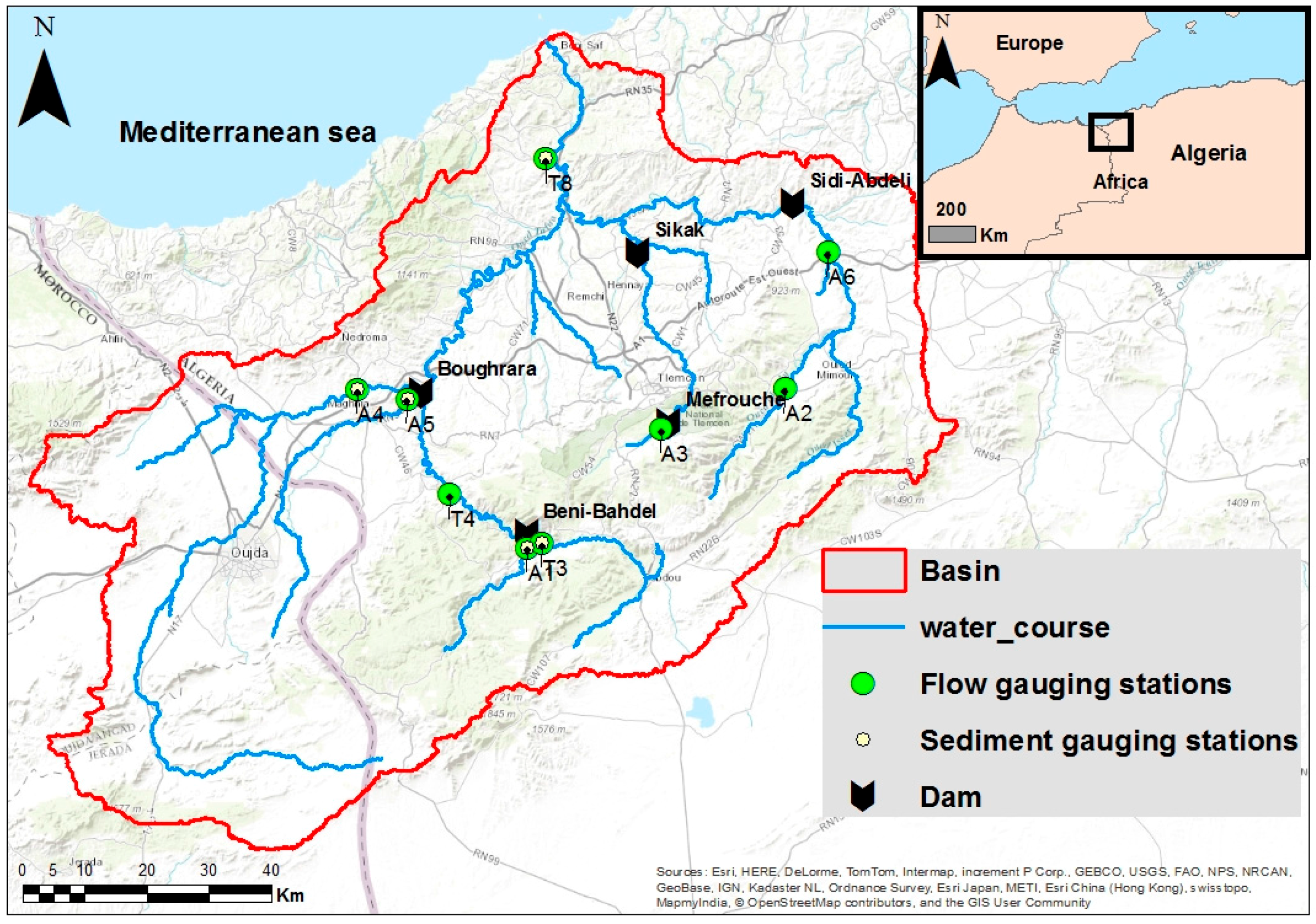
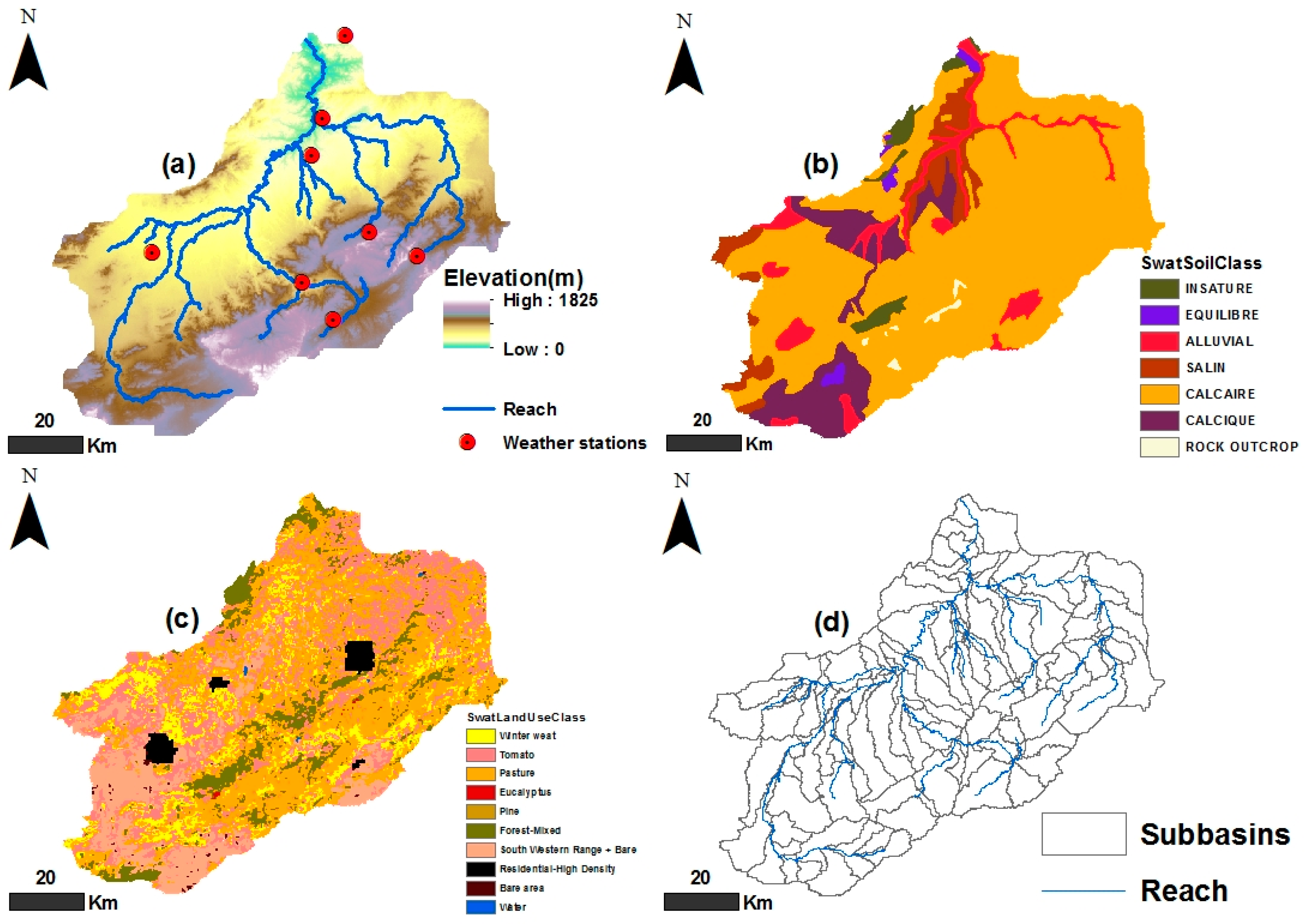
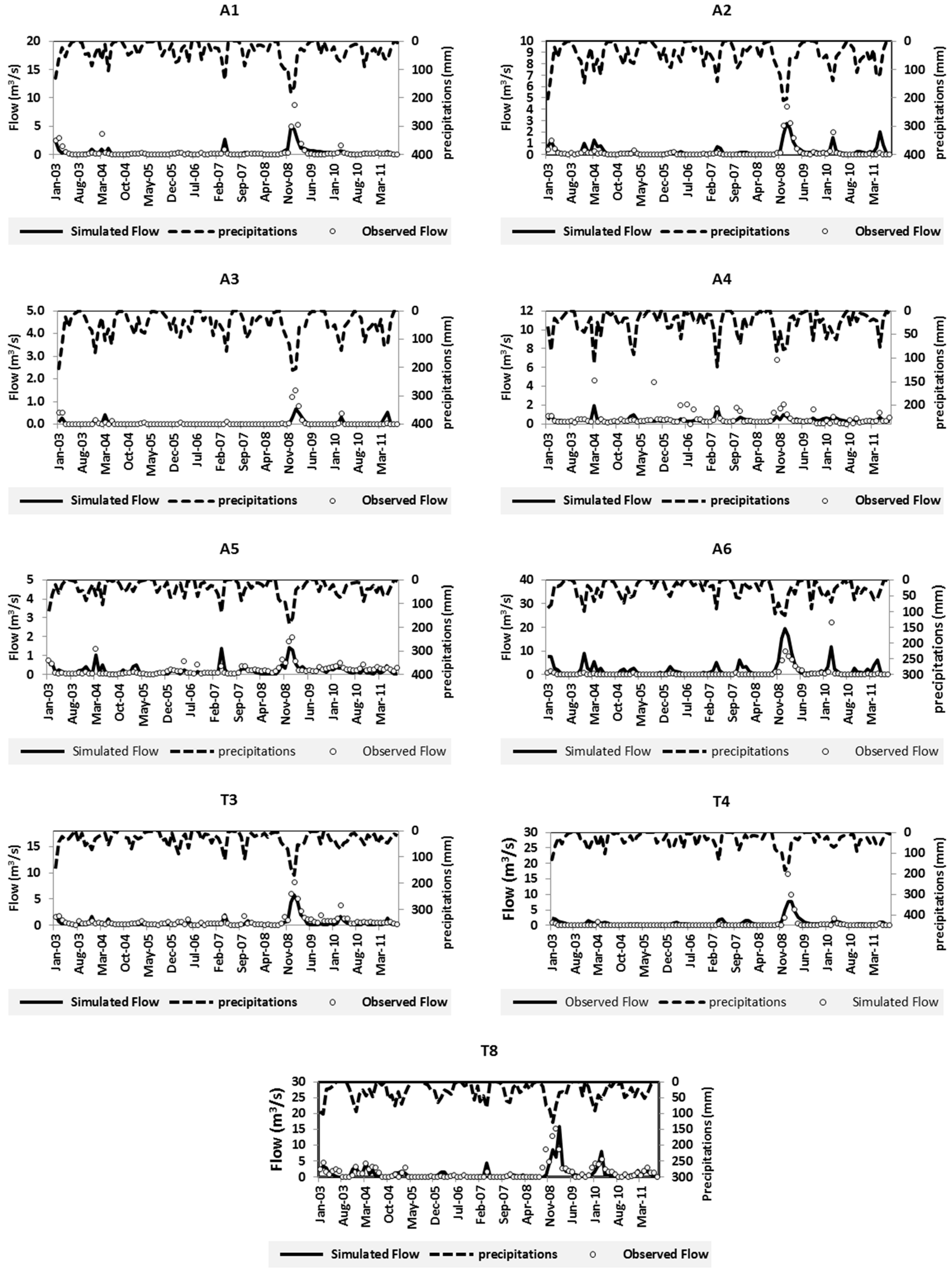

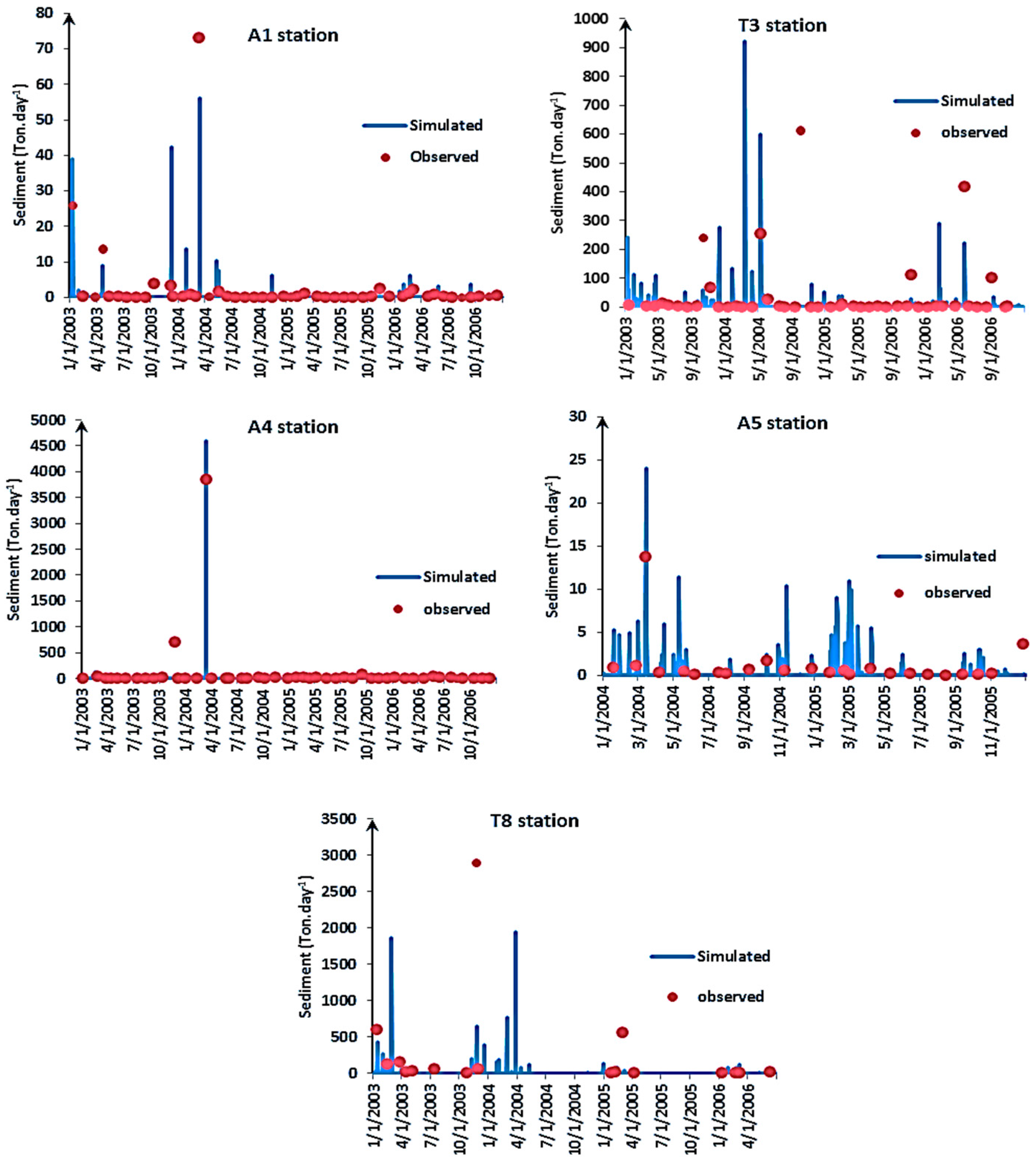
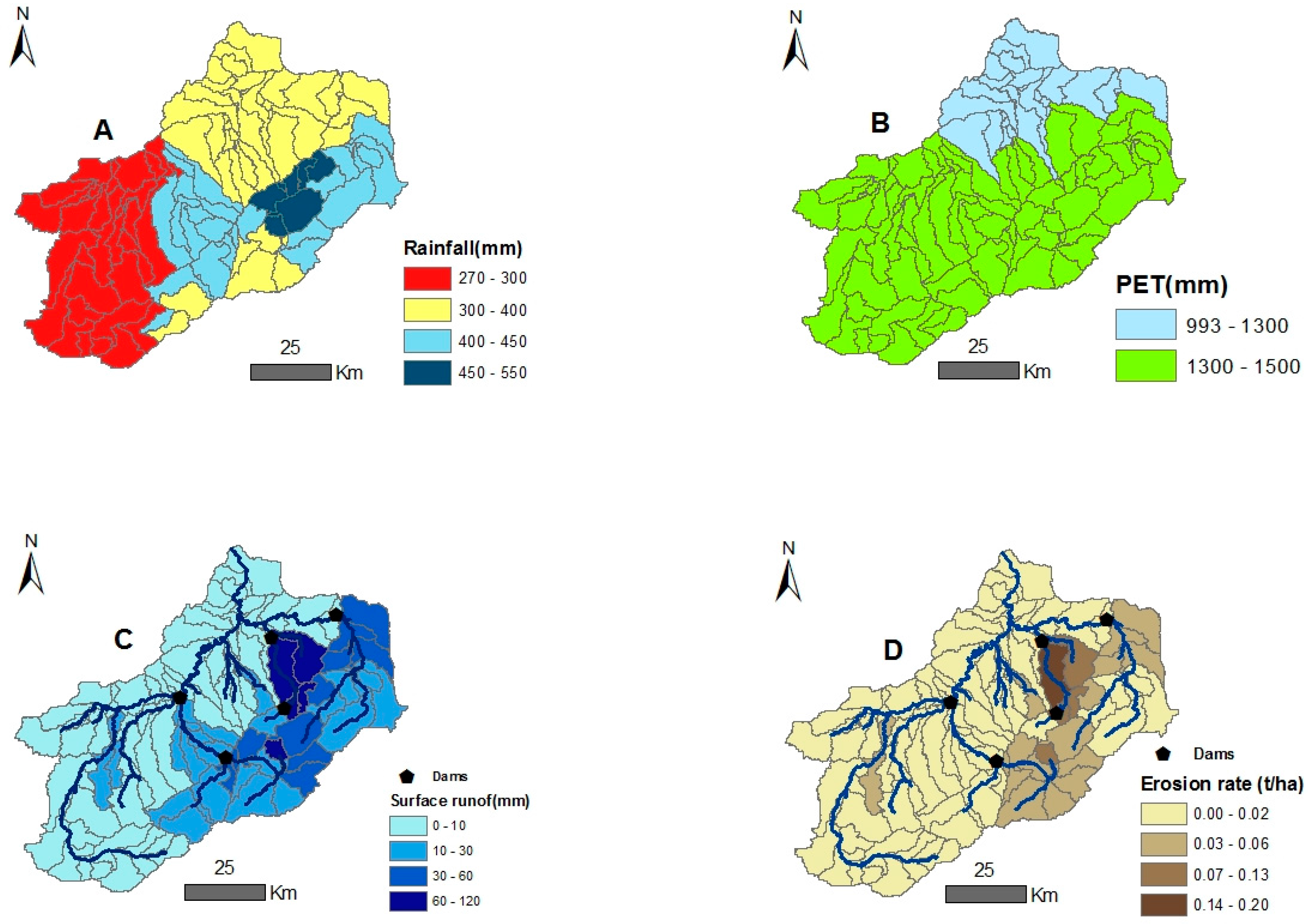
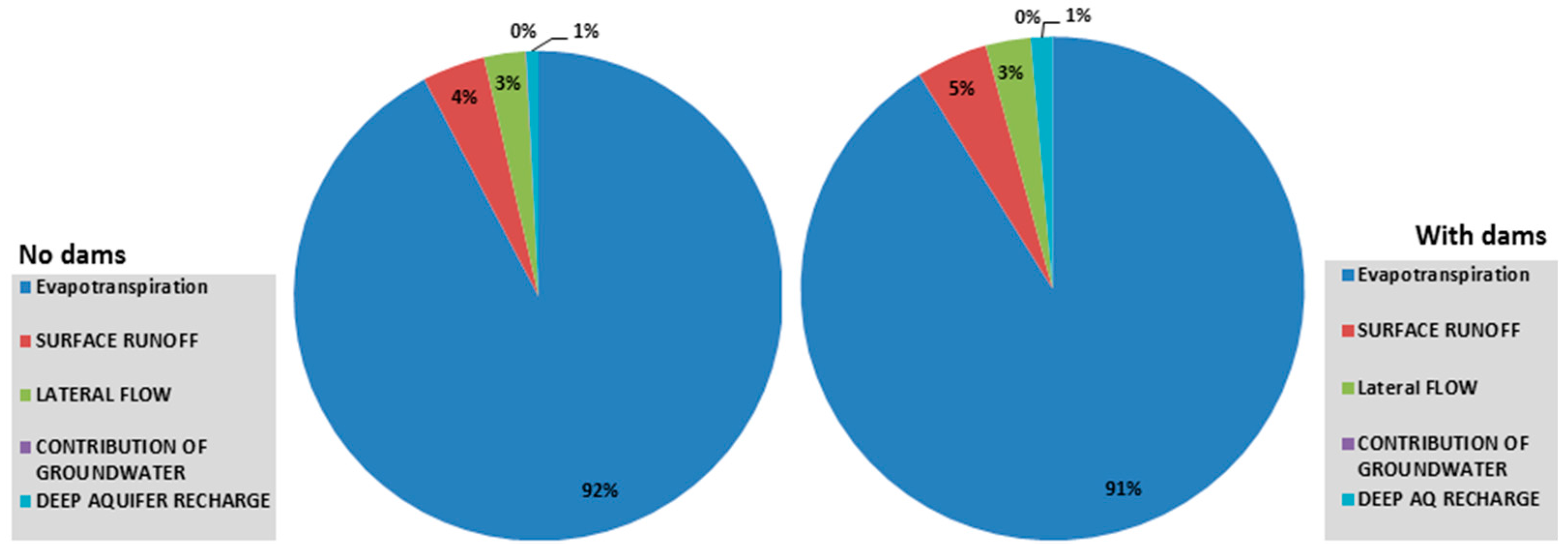

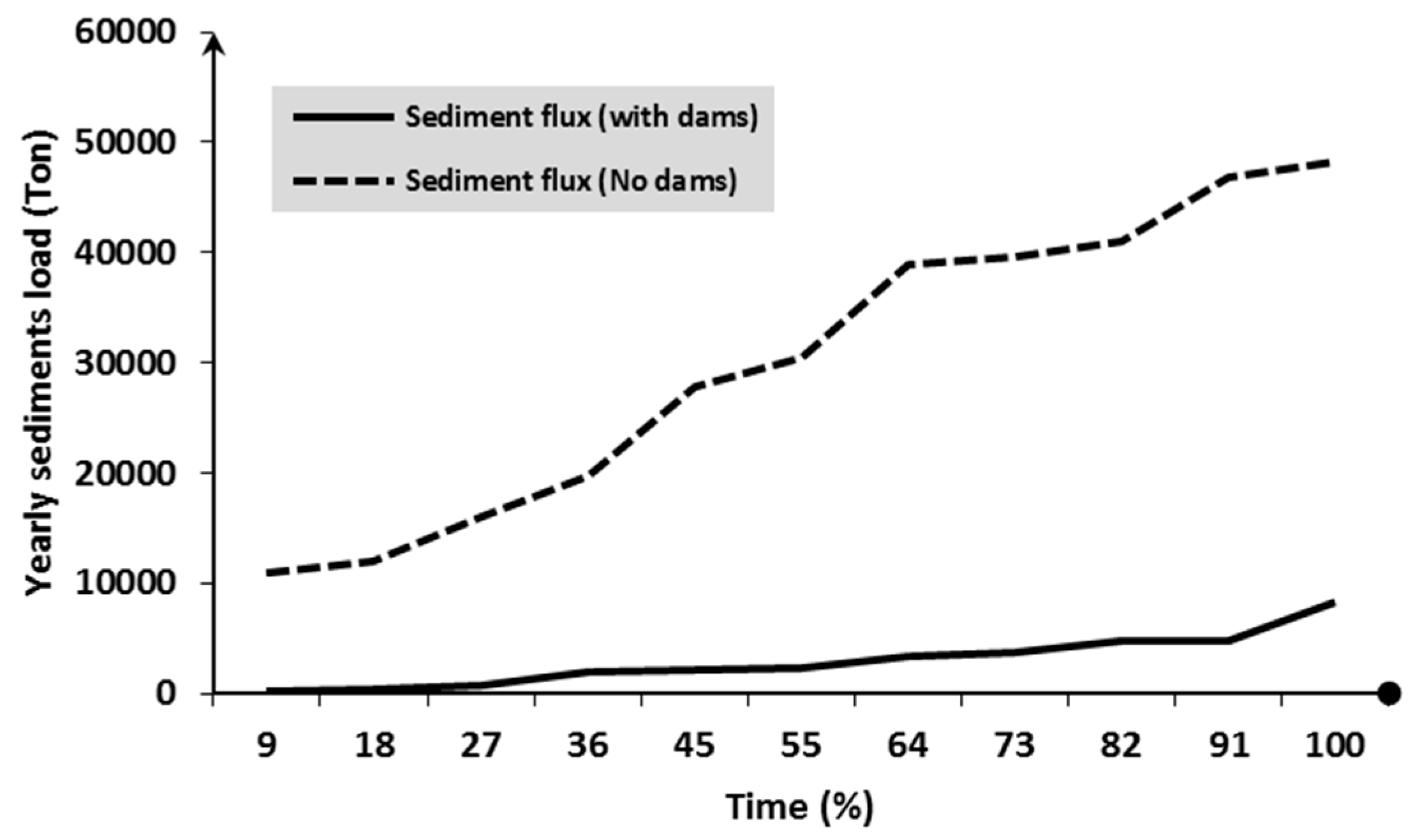
| Dams | Capacity (Mm3) | Construction Date | Used for |
|---|---|---|---|
| Beni Bahdel | 65.5 | 1952 | Drinking water/irrigation |
| Hammame Boughrara | 177 | 1998 | Drinking water/irrigation |
| Mefrouche | 15 | 1963 | Drinking water |
| Sikkak | 30 | 2005 | Drinking water/irrigation |
| Al Izdahar (Sidi Abdeli) | 110 | 1988 | Drinking water/irrigation |
| Parameter | Definition | Units | Initial Range | Calibrated Range | Rank | |
|---|---|---|---|---|---|---|
| Parameters related to flow | CN2.mgt | SCS runoff curve number for moisture condition II | [35; 98] | [38.5; 94] | 3 | |
| SOL_Z.sol | Depth from soil surface to bottom of layer | (mm) | [0; 4500] | [1500; 3500] | 16 | |
| SOL_AWC.sol | Soil available water storage capacity | (mm H2O/mm soil) | [0; 1] | [0.116; 0.169] | 7 | |
| SOL_K.sol | Soil conductivity | (mm·h−1) | [0; 2000] | [4.71; 180] | 14 | |
| ALPHA_BF.gw | Base flow alpha factor characterizes the groundwater recession curve | (days) | [0; 1] | [0.055; 0.975] | 4 | |
| GW_DELAY.gw | Groundwater delay: time required for water leaving the bottom of the root zone to reach the shallow aquifer | (days) | [0; 500] | [89.223; 176.363] | 13 | |
| GW_REVAP.gw | Groundwater ‘‘revap’’ coefficient: controls the amount of water which evaporates from the shallow aquifer | [0.02; 0.2] | [0.069; 0.191] | 9 | ||
| REVAPMN.gw | Threshold depth of water in the shallow aquifer for ‘‘revap’’ to occur | (mm) | [0; 1000] | [185; 892.294] | 12 | |
| RCHRG_DP.gw | Deep aquifer percolation fraction | [0; 1] | [0.176; 0.673] | 2 | ||
| ESCO.hru | Soil evaporation compensation coefficient | [0; 1] | [0.50; 0.86] | 5 | ||
| OV_N.hru | Manning's "n" value for overland flow | [0.01; 30] | [0.177; 0.823] | 11 | ||
| CH_N2.rte | Manning’s ‘‘n’’ value for the main channel | [−0.01; 0.3] | [0.01; 0.2] | 10 | ||
| CH_K2.rte | Effective hydraulic conductivity of main channel | (mm·h−1) | [−0.01; 500] | [58; 406] | 8 | |
| EVRCH.bsn | Reach evaporation adjustment factor | [0.5; 1] | 0.669 | 6 | ||
| TRNSRCH.bsn | Fraction of transmission losses from main channel that enter deep aquifer | [0; 1] | 0.211 | 1 | ||
| SURLAG.bsn | Surface runoff lag coefficient | [0; 1] | 2.15 | 15 | ||
| Parameters related to sediment | USLE-K.sol | USLE soil erodibility factor | 0.013 (t·m2·hr)/(m3·t·cm)) | [0; 0.65] | 0.005 | 1 |
| USLE-P.mgt | USLE equation support practice factor | [0; 1] | [0.003; 0.8] | 2 | ||
| PRF.bsn | Peak rate adjustment factor for sediment routing in the main channel | [0; 1] | 0.18 | 3 | ||
| Stations | NSE | R2 |
|---|---|---|
| A1 | 0.67 | 0.7 |
| A2 | 0.67 | 0.7 |
| A3 | 0.53 | 0.58 |
| A4 | 0.42 | 0.25 |
| A5 | 0.59 | 0.62 |
| A6 | 0.5 | 0.49 |
| T3 | 0.75 | 0.84 |
| T4 | 0.66 | 0.73 |
| T8 | 0.51 | 0.53 |
© 2017 by the authors. Licensee MDPI, Basel, Switzerland. This article is an open access article distributed under the terms and conditions of the Creative Commons Attribution (CC BY) license ( http://creativecommons.org/licenses/by/4.0/).
Share and Cite
Zettam, A.; Taleb, A.; Sauvage, S.; Boithias, L.; Belaidi, N.; Sánchez-Pérez, J.M. Modelling Hydrology and Sediment Transport in a Semi-Arid and Anthropized Catchment Using the SWAT Model: The Case of the Tafna River (Northwest Algeria). Water 2017, 9, 216. https://doi.org/10.3390/w9030216
Zettam A, Taleb A, Sauvage S, Boithias L, Belaidi N, Sánchez-Pérez JM. Modelling Hydrology and Sediment Transport in a Semi-Arid and Anthropized Catchment Using the SWAT Model: The Case of the Tafna River (Northwest Algeria). Water. 2017; 9(3):216. https://doi.org/10.3390/w9030216
Chicago/Turabian StyleZettam, Amin, Amina Taleb, Sabine Sauvage, Laurie Boithias, Nouria Belaidi, and José Miguel Sánchez-Pérez. 2017. "Modelling Hydrology and Sediment Transport in a Semi-Arid and Anthropized Catchment Using the SWAT Model: The Case of the Tafna River (Northwest Algeria)" Water 9, no. 3: 216. https://doi.org/10.3390/w9030216






